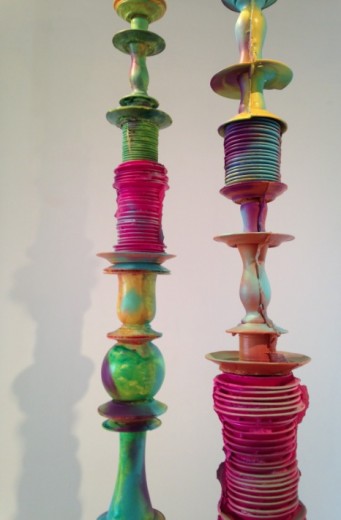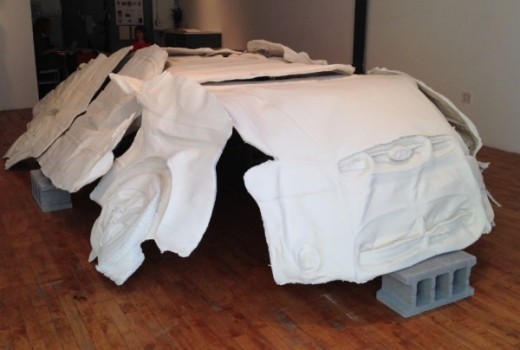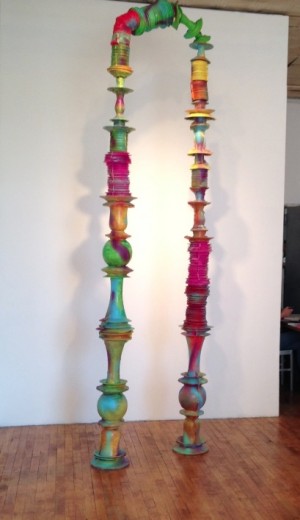
Jude Tallichet “U Turn” at Studio 10
Jude Tallichet juxtaposes a life-sized vehicle, deconstructed into ten pieces, and a tall arch modeled from stacked ceramic plates. Cast in Forton—an acrylic based concrete-like material—these two large scale sculptures are ambitious physical feats. The work lies in an in-between or dual state, funky yet elegant, serious yet humorous, as are the six cast bronze iPhones with engraved phrases such as “There are many realities” or “I’m a little drunk.”
 It is described in the show’s literature as “alluding to the shift in America from optimism of our old ‘open road’ culture to the present state of malaise.”
It is described in the show’s literature as “alluding to the shift in America from optimism of our old ‘open road’ culture to the present state of malaise.”
I view the show as a commentary on our current dystopian state. While this is certainly true, I still feel an overriding (over-arching) optimism in its creation. My own initial interpretation upon viewing the work was Tallichet was combining two concepts: of driving and of architecture.
“Arch” is barely architecturally functional as an entry way, and its height at 11 feet is absurdly high in relationship to its width of 2.5 feet, and therefore the arch is abruptly U turned in shape. I came to the realization that a U turn is absurd unless practiced in motion, of time and space. The physical manifestation created by stacking ceramic plates and crockery is well, simply a comical interpretation of an art historical endless column concept. Beautifully and expressively painted in garish pastels of pinks and blues, it becomes the equivalent of a bright caution sign, caveat emptor, to going nowhere.
“Relic” is a casting of a Honda 2000, done in ten pieces, each piece a remarkable element each in their own right. The 10 pieces are propped up on stacked cinderblocks, creating a kind of sweat lodge look. Stiff and elegant, the sculpture oddly projects a deflated soft sculpture sensibility, but the way it is assembled mimics primitive architecture. There are gaps into the interior that are so inviting they make me want to crawl in, the way we would crawl into forts made of blankets and chairs, as kids.
It’s interesting to think about how car culture has pushed the extremes of commuting with the average commute time increasing yearly. We are literally living in our cars.
In this exhibition there is also an edition of 6 cast bronze iPhones called Small Monuments. They are architectureless. One never knows where someone might be when you call them, certainly not at their wall mounted kitchen phone.
 The small bronzes fit perfectly and reassuringly in the human palm. I read that smart phones are so popular because of the way they fit in one’s palm, and that palm-size objects, things we can hold intimately, inspire feelings of love. In this case feelings of love are addicting and obsession forming. Like the U turn, the endless refreshing of content that doesn’t change (note the final scene of The Social Network).
The small bronzes fit perfectly and reassuringly in the human palm. I read that smart phones are so popular because of the way they fit in one’s palm, and that palm-size objects, things we can hold intimately, inspire feelings of love. In this case feelings of love are addicting and obsession forming. Like the U turn, the endless refreshing of content that doesn’t change (note the final scene of The Social Network).
I think about why Tallichet chose to represent these three objects, the impact they have had on human civilization and development. These three objects depicted a significant influence through out our history. The introduction of the stone arch allowed for grander scaled buildings, creating more space; think Roman coloseums. The car revolutionized individual mobility and freed people and families to go where they wanted as a way of conquering more space. Now the iPhone is truly freeing us physically, except from our phones, altering forever how we function.
Jude Tallichet “U Turn”
Studio 10 Gallery through Nov. 9
56 Bogart Street, East Williamsburg
www.studio10bogart.com
Leave a Reply